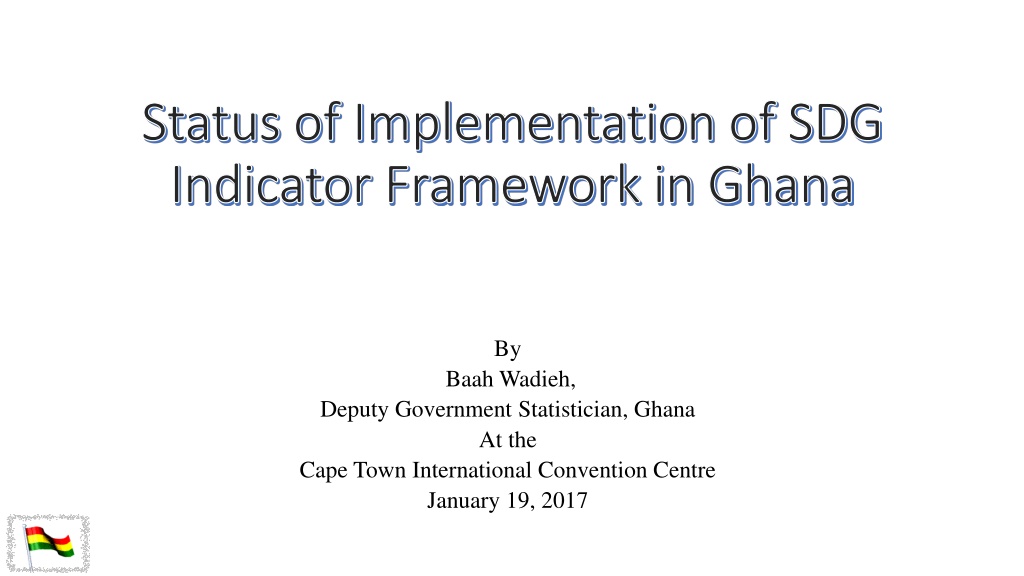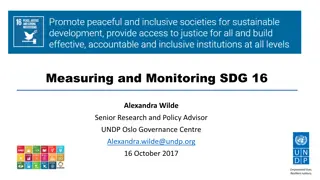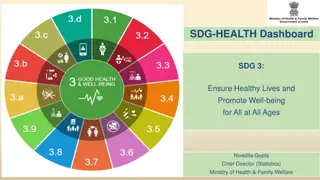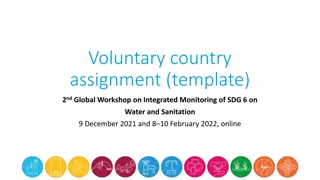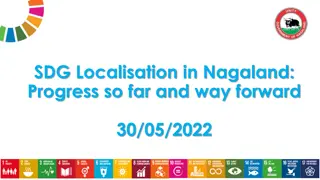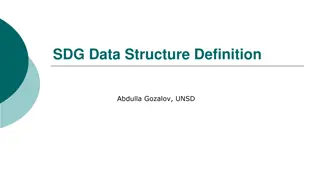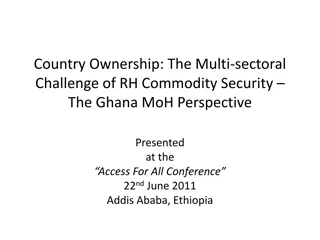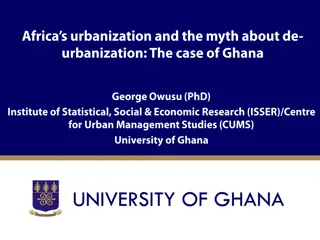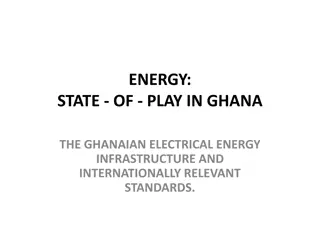Implementation of SDG Indicator Framework in Ghana
Presentation by Baah Wadieh, Deputy Government Statistician of Ghana, at the Cape Town International Convention Centre on January 19, 2017, discussing the legal framework, long-term national development plan, and activities to increase data production in Ghana. The presentation highlights the existing legal framework governing statistical activities, Ghana's Long Term National Development Plan (LTNDP) overlapping with AU Agenda 2063 and UN Agenda 2030, and the goals of the LTNDP focusing on economy, society, communities, institutions, and international affairs.
Download Presentation

Please find below an Image/Link to download the presentation.
The content on the website is provided AS IS for your information and personal use only. It may not be sold, licensed, or shared on other websites without obtaining consent from the author. Download presentation by click this link. If you encounter any issues during the download, it is possible that the publisher has removed the file from their server.
E N D
Presentation Transcript
Status of Implementation of SDG Status of Implementation of SDG Indicator Framework in Ghana Indicator Framework in Ghana By Baah Wadieh, Deputy Government Statistician, Ghana At the Cape Town International Convention Centre January 19, 2017
This presentation talks about Legal framework SDG implementation plan Long Term National Development Plan Linking the data needs Data availability Activities to ensure increased data production Way forward 1 October 2024 2
Existing legal framework Statistical activities of the National Statistical System in Ghana is governed by the Statistical Service Law, PNDC Law 135, enacted in 1985 and the 1993 Civil Service Law, PNDC Law 327, which requires each Ministry to establish a Research, Information, Statistics and Public Relations Directorate
Ghanas Long Term National Development Plan (LTNDP) Ghana is preparing a Long Term National Development Plan (2018 - 2057) The LTNDP overlaps with AU Agenda 2063 (2014 2063) and UN Agenda 2030 (2016 2030) To avoid the proliferation of national plans in response to the global, regional and national agenda, the National Development Planning Commission (NDPC) leading the developing a national development framework which will incorporate Agenda 2030 and Agenda 2063 As part of the process, the SDGs Implementation Coordination Committee comprising representatives from selected Ministries, Agencies and Departments (MDAs) has been formed to provide strategic direction for the SDGs related activities The committee will also provide technical support to the High Level Inter-Ministerial Committee on the SDGs, chaired by HE the President Technical Committee currently mapping all three agenda and identifying specific MDAs/CSOs/NGOs to lead implementation of specific SDG targets 4
The Five Goals of the LTNDP Build an industrialised, inclusive and resilient economy Create an equitable, healthy and disciplined society Build safe, well-planned and sustainable communities Build effective, efficient and dynamic institutions Strengthen Ghana s role in international affairs 5
Linking the data needs SDGs Agenda 2063 LTNDP 6
Data Determination Process Given Ghana s decision to incorporate the SDGs into the LTNDP and the fact that most of the Goals of Agenda 2063 are aligned with the SDGs: GSS initiated a process since April 2016 to review the global set of SDG indicators to determine data availability within the NSS The review generally focused on: data availability for each indicator (classified as tier I or II) data sources Institution producing the data most recent year data is available frequency of compilation levels of disaggregation Other possible data sources 8
Outcome of the review (1/2) Administrative data sources All sources 144 Number Percent 124 Indicator already produced 63 30 47.6 indicator not produced but data exist (with limitations) 61 43 70.5 20 Total 124 73 58.9 Tier I&II Avalaible Gap 9
Outcome of the review (2/2) The process has enabled the GSS to identify the indicators that can be monitored with its current survey and future survey programmes Example: GLSS7, currently underway, will collect data for monitoring 36 SDG indicators 46 MDAs and other institutions identified for data production mostly administrative data Programmed activities to review administrative data and data collection templates of the MDAs in quarter one of 2017
Activities to ensure increased data production (1/5) The National Strategy for the Development of Statistics (NSDS) has over the years provided a strategy for the National Statistical System (NSS) NSDS I (2009-2013) elapsed, but relevant activities still being implemented in the 10 MDAs until Mid 2018 NSDS II document (2017-2021) launched in Accra on November 25, 2016 NSDS II expected to have increased funding for MDAs statistics production 11
Activities to ensure increased data production (2/5) Core Associated NSDS II has six strategic goals 1 Ghana Statistical Service Ministry of Trade and Industry Ministry Communications Office of the Head of Civil Service Judicial Service 2 Ministry of Lands and Natural Resources Ministry of Employment and Labour Relations Ministry of Health/ Ghana Health Service Ministry of Education of Improve the policy, regulatory and institutional framework Improve human resource development and management Modernise physical infrastructure Update statistical infrastructure Enhance data production, quality, dissemination and use Develop sustainable funding arrangements and establish collaborations with national and international institutions 3 4 5 Energy Commission 6 Births and Deaths Registry 7 Registrar General 8 National Communication Authority 9 Ministry of Water Resources, Works and Housing Ghana Police Service 10 11 National Road Safety Commission 12 Environmental Protection Agency 13 Ghana Immigration Service 14 Ministry of Tourism, Culture, and Creative Arts Ministry of Food and Agriculture 15 **New MDAs included based on SDG data required 16 Ministry of Gender, Children and Social Protection 12
Activities to ensure increased data production (3/5) Improving policy, institutional and regulatory framework New Decentralization Bill The bill has a provision for the establishment of Statistics Department in each of the 216 MMDAs Collaborating with the Local Government Service Secretariat to establish a Statistics Department in each of the MMDAs Restructuring the Service operating up to the regional level and to give technical backstopping services to the MMDAs Human resource capacity building providing advanced training (MSc) in priority subject areas for GSS and MDAs staff Collaborating with research and other institutions to build capacity in data analysis poverty analysis 13
Activities to ensure increased data production (4/5) Formation of statistics and development team - NDPC & GSS Assessment for strengthening statistics in national development planning underway To assess the state of statistical development, the availability of quality data within the decentralized planning system (MDAs & MMDAs) Statistical Service Law being revised and strengthened first reading in Parliament in October 2016 New Law expected to strengthen the role of GSS in coordinating the NSS Moving from PAPI to CAPI to reduce the time lag between completion of data collection and publication of results Collaborating with PARIS21 to develop data dashboard for monitoring NSDS II & SDG implementation ADAPT Efforts underway to open all data (microdata and metadata) Discussions underway to develop Data Quality Assurance Framework 14
Activities to ensure increased data production (5/5) information Policy/ decision- maker Policy-related Analysis Basic Analysis End point of most existing data Tables Raw Data 15
Way Forward Regular and improved use and dissemination of statistical products open data platform/data dashboard Review national statistical capacity gaps Build Align Agenda 2030 & 2063 with LTNDP partnerships for increased statistics production Refine and localise indicators for Ghana 16
